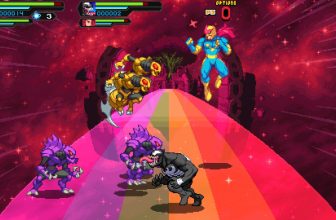
An All-Time Great RPG Gets Even Better
If you asked the average person to imagine the perfect video game, it probably wouldn’t be something limited by the original PlayStation’s R3000 processor and 2MB of RAM. The majority of it probably wouldn’t take place in crude, polygonal 3D dioramas floating in empty space, brought to life by 32-bit sprites that look like archaic cloth dolls whose faces have no noses. If there were dramatic action, it definitely wouldn’t all be ploddingly turn-based, confined to grids, and governed by opaque math that’s viscerally felt rather than clearly understood.
I feel confident they wouldn’t think up anything close to Final Fantasy Tactics, but nearly three decades later, Square Enix’s 1997 spin-off remains a shockingly clever, intimate, and effective masterpiece. It tells an existential tale of conspiracy and betrayal using Shakespearean puppets who are as defined by their morality and ambition as they are by their ever-evolving Dungeons & Dragons stat sheets. There are no villains or heroes in Final Fantasy Tactics, just people corrupted by power and those unwilling, even in the face of bitter death, to trade their humanity for it.
How do you improve on that? What would you add to Pet Sounds or Apocalypse Now in the year 2025 to make them better? This is the impossible task laid at the feet of Final Fantasy Tactics: The Ivalice Chronicles, a ground-up remaster that tries to stay faithful to the original while softening its harder edges for modern audiences and smoothing over its classic pixel art for HD displays. It succeeds more often than not, with a raft of small tweaks I now can’t live without and a new hard mode that has been kicking my ass and making my latest playthrough feel nearly as urgent as my first.
Still the best Final Fantasy story
Final Fantasy Tactics begins with the kidnapping of a princess and ends with a showdown in hell. The end of one war turns into the start of another as a succession fight in Ivalice plunges an already broken nation into civil war. At the center of it is the nobleman-turned-mercenary Ramza Beoulve, whose winning mix of naive idealism and an unshakable sense of justice make him a formidable foil for Machiavellian plots plunging the kingdom into chaos. But Final Fantasy Tactics is a game about history, not fairy tales, and there are no happy endings awaiting Ramza or anyone else in Ivalice. There is only the peace they make for themselves by deciding what’s right and accepting no substitutes.

When the game starts, Ramza is fresh out of the military academy and ready to crack some peasant heads for rising up against the aristocracy. Along with lowborn pal Delita, he’s tasked with putting down a local rebellion by veterans returning home from a foreign war who now demand a voice in governance the same way they had one on the battlefield. Cast as thieves and kidnappers, the members of the budding revolutionary movement find themselves being mercilessly cut down by the spoiled youngest child of one of Ivalice’s most powerful families.
Only after a series of chance encounters with the leaders of that movement does Ramza experience the slow-dawning realization that those in power are more concerned with maintaining it than with using it to benefit others. The end of his first military campaign proves a tragic awakening as he and Delita are sent spinning off along inverted and irreconcilable trajectories. The ideological wool clipped from his eyes, Ramza must try to save Ivalice from ruin with no army at his back and no clear beliefs to guide him.
D&D chess at its peak
It’s against this grim but hopeful medieval backdrop that Final Fantasy Tactics has you tinkering with one of the best class customization systems of any RPG, deployed across one of the best combat systems of any turn-based strategy game. Your burgeoning squad of misfits can train to become everything from armor-breaking knights and potion-dispensing chemists to master mimics or warriors wielding literal math to bring their enemies to heel.
Each of these jobs has innate strengths and weaknesses as well as underlying stat growth bonuses that accrue as you level up. You can also mix and match different abilities from different jobs after you’ve acquired enough points during combat to unlock them. This includes not just active abilities but also passives, counters, and movement bonuses. Want a White Mage who steals weapons, walks on lava, and carries a gun? You can do that. Want a Samurai who teleports around the map, dual-wields magical staves, and can summon Bahamut? You can do that, too.

Some of these combos are a mess. Others are completely OP. Exploring the contours delineating those two is one of the big pleasures of Final Fantasy Tactics, the rare strategy RPG that is happy for you to leverage any trick available to not just survive the battle but completely dominate it. By the time you’ve unlocked and mastered the game’s final handful of jobs, enemies can be disabled or completely wiped out from across the map before they ever reach you.
While unit positioning, loadouts, and turn order play defining roles in the game’s early battles (I’m looking at you, Dorter Slums), these familiar rhythms begin to shift and are eventually upended across the game’s four chapters. Early wars of attrition give way to brawls that quickly turn in your favor as you one-shot enemies with clever buildcrafting. Where some strategy games try to recreate the grand scale of big armies colliding, Final Fantasy Tactics recreates the operatic pageantry of an epic turn-based RPG fight instead, and all of the chaotic peaks and valleys that comes with it.
Giving an all-time classic a fresh voice
Original director Yasumi Matsuno has re-edited the script, based on the War of the Lions PSP port, and it’s fully voiced now. The result is a much clearer and more natural-sounding localization in which each character’s personality comes through in more nuanced ways. One-note villains like the Fell Knight Goffard Gaffgarion and the Grand Duke Gerrith Barrington are given slightly more room to explain themselves and convey their motivations. Fan-favorite comrades like Agrias Oaks and Cidolfus Orlandeau get the opportunity to shed more light on their backstories before being abruptly shuffled offstage.
Final Fantasy Tactics: The Ivalice Chronicles
-
Back-of-the-box quote:
“Still one of the best to ever do it”
-
Developer:
Square Enix
-
Type of game:
Strategy RPG
-
Liked:
Grim but heartfelt story, intricate job system, all-time soundtrack, and tons of welcome improvements
-
Disliked
Some of the visual trade-offs, occasional voice acting misses, and the lack of new content
-
Platforms:
PS5 (played), PS4, Xbox Series X/S, Xbox One, Switch 2, Switch, PC
-
Release date:
September 29, 2025
-
Played
Beat the main campaign and completed some side quests. About 25 hours.
I’m not a fan of all of the new writing. There are some scenes in the back half of the game that start to feel like slightly verbose retreads of points characters have already made in the past but feel compelled to rehash before locking swords. There was also an uncluttered directness to some of the lines in the original English version of Final Fantasy Tactics that has been sanded off in the remaster. It does include the “original” version of the game, but only with the Elizabethan-inspired script of the War of the Lions rewrite. As mangled and confusing as it was in spots, that original version, complete with “blame yourself or god,” deserves a place in the remaster as well.

There are some hitches in the visual overhaul as well. While most of The Ivalice Chronicles does an excellent job of recreating the original aesthetic in HD, and I eventually came around to the more modern font and UI styles, there are some scenes in which the new textures look unimpressively flat without the depth of their original pixel art. Animation-wise, the remaster is almost completely free of slowdown. If there’s one area in which the new version arguably looks worse than the original, it’s the summons. Shiva, Titan, Bahumut and others feel a bit abridged and washed out. These are the definition of nitpicks, however, and unless you’ve played hundreds of hours of Final Fantasy Tactics too, you’ll probably have no idea what I’m talking about.
Even if there were bigger issues that felt like deal-breakers, many of them would be worth the trade-off for the other improvements The Ivalice Chronicles makes. Amid myriad minute tweaks, the most obvious is the fact that you can now reset your character’s movement before they act and you can fast-forward through any part of the game. In addition, random encounters on the world map are now optional when traveling between locations and you can set custom loadouts for characters that you swap between on the fly. Complete with a new lore recap page and map markers that make it easier to track side quests, Final Fantasy Tactics is more new-player-friendly than ever, without compromising any of its core virtues.
The new hard mode is no joke
Much has been made of Square Enix’s decision not to add any new jobs or meaningful additional side content to the remaster. In lieu of any of that, I’ve been pleasantly surprised by just how challenging the game’s new hard mode is. While easy mode is very forgiving and even normal has been tuned in players’ favor, the highest difficulty setting has seen me get my teeth kicked in, even during throwaway battles I never used to worry about.
While the battles appear the same, complete with the same exact enemy builds and layouts, opposing units hit much harder and don’t go down easily. I thought this would keep me on my toes mostly in the earlier part of the game when my party was still growing into their best jobs and acquiring their strongest skills. Instead it’s been dogging me throughout the entire game, forcing me to grind, be mindful of the team I’m fielding, and play conservatively once the battle has started.

One big factor is a change to how long certain skills take to charge during combat. Archer attacks and powerful spells can now be cast in only a handful of turns when they used to be so slow they were borderline useless. It’s great for players who want to experiment with some of the game’s more overlooked abilities, but it’s also a gift to enemies who can now wreck you twice as quickly. Gameplay remains beautifully broken in all the right places, but the hard mode pushes players to work a little harder to find those pressure points and exploit them.
I thought I was ready for the worst in the game’s infamous battle at Riovanes Castle only for it to punish me in new and unexpected ways. Some of these skill checks are cheap and arbitrary, but that feels right for a game that’s all about looking at spreadsheets of stats and abilities and finding ways to cheat the system. A well-known exploit for the battle in question remains active in the game, despite being derived from a coding error decades ago. These aren’t messy wrinkles to be ironed out. They’re unique blemishes that remind you Final Fantasy Tactics was built by people for people.
The Ivalice Chronicles isn’t the perfect version of Final Fantasy Tactics I can imagine in my head, but it’s unquestionably the best version of the one that actually exists. The Ivalice Chronicles, like its protagonist Ramza Beoulve, stands athwart history a flawed but uncompromising messenger with one simple plea: “Go back and play one of the best games ever made.”






